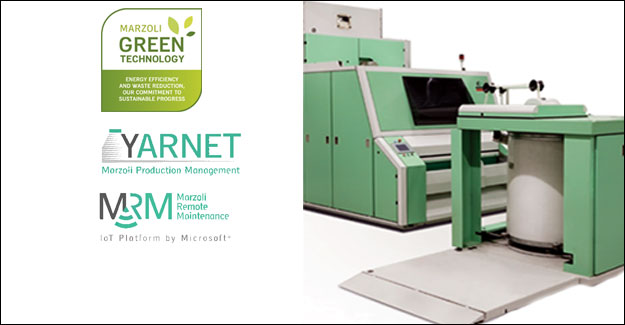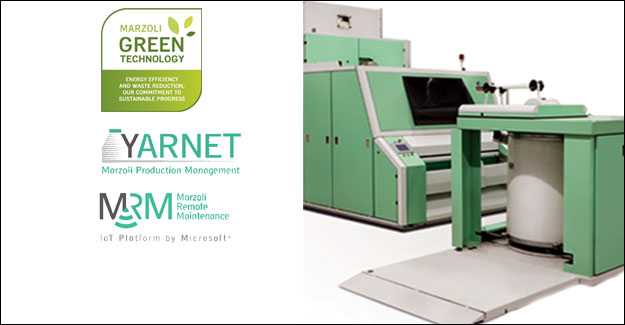
Marzoli's Advanced C701 Card Delivers Quality And Productivity
The carding has always been at the heart of the spinning process. Only with effective carding of the fibre a spinner could produce homogeneous, regular and clean yarn. No machine in the spinning mill can remove the defects that arise from non-effective carding, therefore it is necessary that the card can properly open, clean and parallelize the fibres without damaging or weakening them.
Carding technology has become even more important with the advent of high production requirements. Gone are the times when spinning mills used to have several cards running at 20-30 Kg/hr and require high production cards in order to minimize the cost. But increase in production can have serious effects on the quality of the output, therefore technological innovation has become fundamental to meet demanding requirements.
This article is to describe latest model of Marzoli's C701 card from a technical and technological standpoint, highlighting the advancements achieved in carding technology.
Machine description
With Marzoli C701 the raw material is supplied via the feed inlet (1). The raw material accumulated in the pre-chute chamber is then clamped between a feed roller (3) and a feed table and is delivered to an opening roller (4) that delivers very fine tufts to the batt formation chamber. The batt is then delivered to a feed device comprising a feed roller (7) and a feed table that delivers the clamped material to the licker-in (8). After having passed through a mote knife and two carding segments that remove the impurities, the material is delivered to the main cylinder (12) and is processed by six carding bars and two mote knives in the pre-carding area (9). The main carding zone (11) comprises 90 mobile flats, thirty two always in working position. The post-carding area (13) comprises 2 mote knives and four carding bars for a further cleaning and parallelization of the fibres. The material is then delivered to the doffer (15), the web detaching device (17) and the sliver formation area (18). The sliver is then coiled inside the 40" cans.
Although the carding principle is still the same, substantial improvements were introduced to achieve high productivity and efficiency. When compared to the previous model, Marzoli C701 delivers 50% increase in production and 30% reduction in energy consumption maintaining the same quality level.
Integrated feed chute
The feed system of the card is of the utmost importance for achieving sliver regularity and on machine productivity. An even sliver can be obtained only if the feed batt presents a perfectly even distribution of the tufts and high production requires that the feedstock is perfectly open.
The feed system of Marzoli C701 is a two-piece chute with an integrated opening system: the material enters the pre-chute feed chamber (the reserve chute) and is then delivered through a feed roller that seals the upper half of the feed system to an opening roller which plucks the clamped material and delivers very fine tufts to the batt formation chamber. The described technology, along with the auto-leveler that adjusts the speed of the feed roller according to the batt width, guarantees the delivery of a perfectly open and even feed batt to the licker-in.
Licker-in
One of the main objectives of a card is to open the fibre material and remove the impurities still present within the feedstock. In a card, the licker-in contributes the most to these.
One of the peculiarities of Marzoli C701 card is the small diameter of the licker-in, which thus rotate faster in order to keep the desired peripheral speed. This generates a greater centrifugal force that, in combination with the knife and the carding segments positioned underneath the licker-in, contributes to a very effective elimination of dust and trash.
It is argued that, to achieve desired degree of opening, several licker-ins are necessary. In reality, the opening of the fibres is carried out through a draft effect that occurs between the feed roller and the main cylinder. In fact, draft is always and only the ratio between the delivery speed and the input speed: the intermediate rollers do not affect the final draft whatsoever. The draft between the feed roller and the main cylinder of Marzoli C701 Card is very high (800) ensuring perfect opening of the fibre mass. This adds onto the high cleaning performance of the licker-in, which does not alter the draft effect.
Carding zone
In order to increase production, the card must process higher amounts of material and therefore, must open more fibres in less time. The opening effect is usually represented by the number of fibres per point, i.e. average of total fibres fed in per unit of time over the number of points available in the same time. Increase in production would require a proportional increase in the number of points available in the time unit and this can be only achieved in two ways: higher roller and cylinder speeds and more carding surface.
Increasing roller and cylinder speed, however, would result in detriment of quality. Also, result in too much stress on the fibres and on the clothing of flats. Therefore, machinery manufacturers have opted for the second option and have revised the geometry of their cards.
In Marzoli C701 card the main cylinder has been raised and the licker-in and the doffer have been located underneath. This entails a carding angle, i.e. angle between the center of the licker-in and the center of the doffer, of 284°. The great carding angle, the diameter of the cylinder of 1 meter and the working width of 1.5 meters entail a carding surface of 3.74 sqm, one of the largest carding surfaces available in Carding machines, thereby reducing the number of fibres per point.
The core of a card is the area of the revolving flats. It is in this zone where the tufts are opened into individual fibres, where the raw material is parallelized, impurities and neps are eliminated and short fibres are removed. Marzoli has equipped its C701 model with 90 mobile flats, 32 of which always in contact with the cylinder for effective carding.
Doffer
The fibres after having been carded must be transferred from the main cylinder to the doffer where they are condensed into a web. This is a critical operation to maintain the sliver evenness and to do this the cylinder and the doffer must be as close as possible to each other. In Marzoli C701 card, the distance between the two rollers is at the minimum mechanically achievable range and the transfer of fibres is achieved by their large contact zone offered by large diameter of the doffer.
Marzoli C701 includes all the features of modern high-performance cards and thanks to its innovative geometry represents a technological benchmark to fully satisfy the drivers of modern competition.

Textile Excellence
If you wish to Subscribe to Textile Excellence Print Edition, kindly fill in the below form and we shall get back to you with details.








